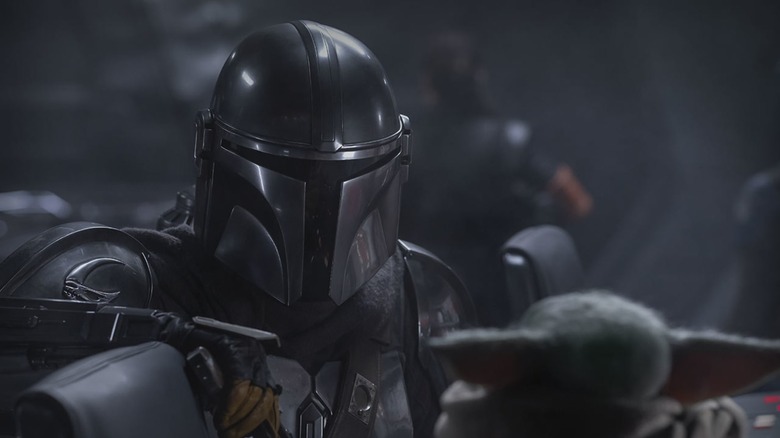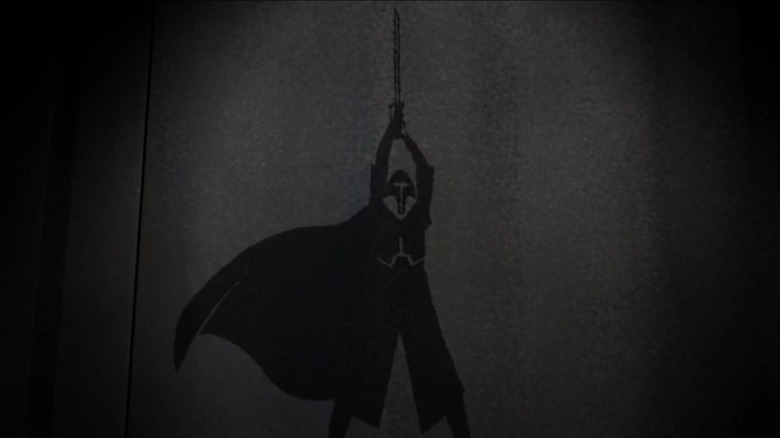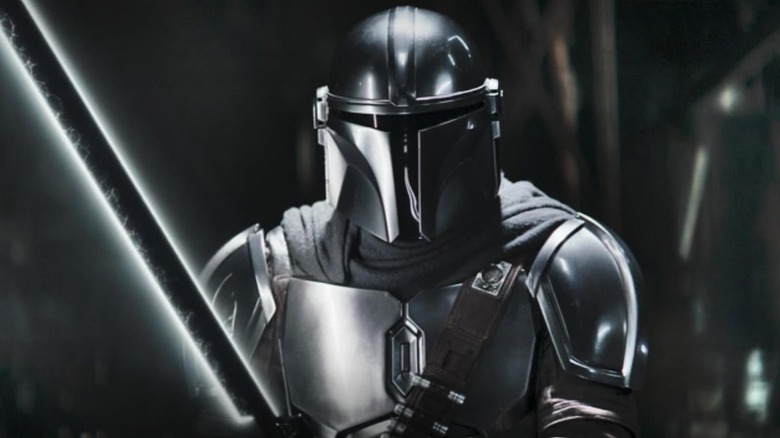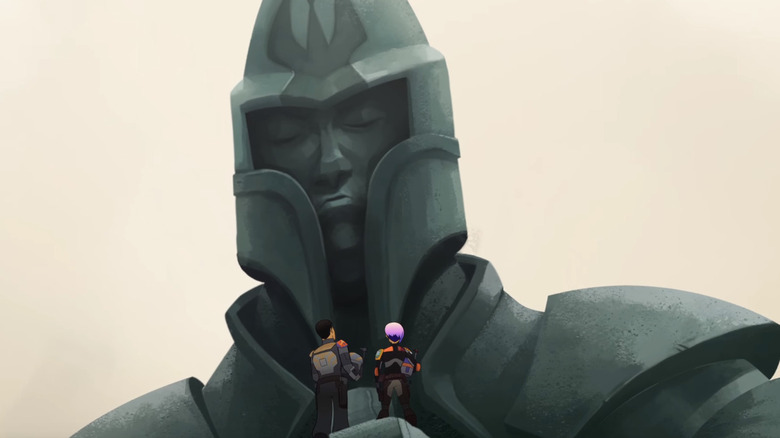Who Is Tarre Vizsla, The First Mandalorian Jedi?
Tarre Vizsla is a tantalizing Star Wars tale that could fill out legions of IP tie-ins, novels, comics, or multi-chaptered fanfictions (this writer here attempted and failed that endeavor). In Chapter 5 of "The Book of Boba Fett," those familiar with the live-action Star Wars TV-verse were introduced to the thousand-year-old legend of Mandalorian Jedi Tarre Vizsla, as invoked by the Armorer when she educates the titular Din Djarin on the Darksaber's first owner and creator.
The legend of Tarre Vizsla is already one "Star Wars: Rebels" viewers heard. Its placement in a recent episode of "The Book of Boba Fett" — really a not-so-subtle extended "The Mandalorian" teaser that diverts from Boba Fett — is interesting.
To recap, having unwittingly won the Darksaber against Imperial Moff Gideon in combat, Din Djarin is now the wielder of Tarre Vizsla's blade. According to tradition, only through a fair duel can the Darksaber be won from him, which was attempted and failed by Paz Vizsla, an ancestor of Tarre. But although the Darksaber is a centerpiece of Mandalorian conflict, what do we know about its original forger and wielder?
The Haze of History
Active during the era of the Old Republic, Tarre Vizsla first manifested as a parrying silhouette in the season 3 "Rebels" episode "Trials of the Darksaber" — AKA, one of the greatest animated moments in Star Wars that illuminate the mythic malleability of history.
Like many Padawans, Tarre Vizsla forged his lightsaber design to be inspired by his background. "Book of Boba Fett" confirms what's suspected but had gone unstated onscreen: the Darksaber hilt is beskar, the Mandalorian metal that's smelted into the Mandalorian signature armor. When Tarre reappears as a statue in a "Forces of Destiny" short, it throws in another revelation: he's a regarded ruler of Mandalore, thus the Darksaber's origin as a symbol of leadership. The fancy details of his regime are left fairly unknown.
Tarre seemed to have constructed his saber (consciously or not, as it's unknown if he ever intended a legacy to carry his saber) for someone of mental fortitude. For those who harbor mental turmoil over their worth, the saber will literally weigh down the user and hinder their combat. It's demonstrated when Sabine Wren feels its heaviness in "Rebels." Din Djarin gets his rude awakening as well — and a leg burn for his troubles — when it slows him in battle.
Importantly, the Darksaber is a relic of disputed ownership, its purpose transformed, co-opted, shapeshifted, reformed, corrupted by a succession of wielders. After Tarre's passing, it was during the Fall of the Old Republic when Tarre's own House Vizsla (a faction made of loyal clans) broke in the Jedi Temple and liberated ("liberated" is a significant choice of word by Mandalorian Protector Fenn Rau) the Darksaber and unleashed it against their adversaries.
The Bloody Legacy of the Darksaber
Tarre wouldn't be proud of his relatives. As witnessed in "The Clone Wars" series, his ancestor Pre Vizsla, eventual leader of House Vizsla and the Death Watch terrorist faction, would flaunt the blade to strike down Jedi, ambush Obi-Wan Kenobi, and commit atrocities on Carlac. Fallen Sith Maul would later successfully duel Pre for the blade, thus claiming the conquered seat of Mandalore for a short-lived regime. Then during the reign of the Galactic Empire, Sabine Wren of Clan Wren salvaged the blade from Maul's lair on Dathomir. Using her judgment, Sabine then granted it to Bo-Katan Kryze based on the latter's leadership experience and pledges of supports from Mandalorian warrior clans. But in the aftermath of the Night of A Thousand Tears, Kryze would lose the Darksaber and it would land in Gideon's nefarious grip.
Tarre Vizsla's Mandalorian warrior identity and his Jedi mantle places him in a fascinating intersection. Prior to his induction with the Jedi Temple, Jedi and Mandalorians warred against each other and those conflicts burned on after his death. Mandalorians forged and smelted the beskar armor and weapons to outmatch or rival the powers of the Jedi — "enemy sorcerers," as Djarin understands them in the Armorer's story. This raises some questions that would be a gold (beskar) mine for anyone who might tackle the IP novel. How was young Tarre scouted by Jedi? A Mandalorian clan wouldn't be likely to sign off on a child joining enemy sorcerers. Was Tarre from a known clan? Paz Vizsla also affirms Tarre as a "founder" of the powerful House Vizsla. Was he an orphan?
How did Tarre navigate the space of a Jedi Temple? How did he harvest the kyber crystal that powered the Darksaber? How much approval then did Tarre attain from the Jedi Council to partake in the affairs of his homeworld to become a ruler"? Speculatively, Vizsla's Jedi induction and his eventual presence on Mandalore could be interpreted as defusing the tension between Jedi and Mandalorian.
Tarre Vizsla left an incalculable impact on Mandalorian history. But disregarding the always-disputed Darksaber, in-universe discourse about Tarre Vizsla, his politics, his practices have yet to surface. "Star Wars" illuminated a myriad of Mandalorians sects and practices: from the orthodox Children of Watch that adopted and educated Djarin, the extremist Death Watch (that may have ties to the Children of the Watch as indicated by the armor insignia of Mandos who rescued a young Djarin), Bo-Katan Kryze's splintered Nite Owls from Death Watch, New Mandalorians under Satine Kryze's pacifist rule which renounced weapons and beskar armor. You could bet you ask any Mandalorian their extensive opinion of Tarre Vizsla's historical influence and expect unique answers.
Tarre Vizsla's Eyes on the Future
Tarre Vizsla may be a specter, but he's nonetheless the specter who illuminates the arcs of those in proximity to the Darksaber. Note that whenever Tarre Vizsla's name has been invoked so far (besides "Forces of Destiny"), adoptive father figures are always the one who absorb his story. Onscreen, the lore of Tarre Vizsla was first told to Kanan Jarrus, the Jedi who trained Sabine Wren to wield the saber. Now, the Armorer tells it to Djarin, Grogu's Mandalorian guardian.
In "Trials of the Darksaber," one of the greatest "Rebels" episode, a major theme of Sabine's Darksaber arc is that family — blood relation or found — shape your perspective and ethos in the galaxy. Sabine is a Mandalorian outcast who was informally "adopted" by a Jedi and received lightsaber training despite her non-Force-sensitive status. In an inversion of Sabine's upbringing, Grogu is a Force-sensitive non-human Jedi youngling who ends up adopted by a Mando in beskar. So powerful is Grogu and Djarin's bond that Djarin bestows Mandalorian heirlooms, his Mando pendant and later the beskar chainmail armor forged by the Armorer. Although Djarin has situated Grogu with the Jedi Luke Skywalker, Djarin is intent on not letting Grogu forget his Mandalorian ties.
As season 3 of "The Mandalorian" looms on the horizon when season 1 of "The Book of Boba Fett" concludes, the weapon of Tarre Vizsla is set on a clouded path. The most obvious obstacle is that Djarin has yet to master mental clarity to properly swing the Darksaber — "Your body is strong, but your mind is distracted," preaches the Armorer. Likely, this would involve his personal turmoils with his Mandalorian identity, in part because the Children of the Watch reject him but he still wears the beskar and its principles. Fans perceive the honorable Din Djarin, a Mando not born of a powerful bloodline, as an ideal candidate to rally all kinds of fractured Mandalorians to rebuild Mandalore. For one, he values solidarity despite his loner status. Two, living up to the Darksaber's symbolism of Mandalorian leadership might help him engage more in Mandalorian history, something which he is still learning. Perhaps to the chagrin of Paz Vizsla, Din's background subverts the nobility ties that often accompany the Vizslas' claim to the sword and leadership.
If Moff Gideon's taunt is any foreshadowing, Grogu might be the narrative candidate to wield the Darksaber (hopefully not involving him defeating Djarin). It makes thematic sense. The Darksaber represents one Mandalorian's cohesion of his Mando-Jedi heritage. In Chapter 6 of "Book of Boba Fett," Luke Skywalker lays out the either-this-or-that choices before Grogu: the traditional lightsaber or the beskar chainmail armor. It's hard not to imagine Grogu's development may be reconciling his Jedi roots and his Mandalorian upbringing, and the Darksaber would be that perfect symbolism.
Can you imagine if even Tarre himself had to learn to lift his own blade when navigating two worlds? He remains a historical influencer, a trove of curiosity, and an omnipresence. He may have ascended to the Cosmic Force, yet he's relevant to Din Djarin and Grogu's bond. The Jedi, Mandalorian, ruler, an ancestor, he's the ghost that watches over a future always in motion for the Djarin clan of two.



